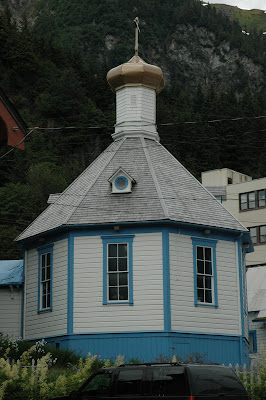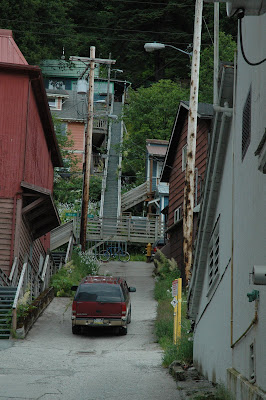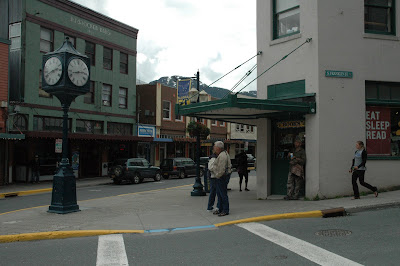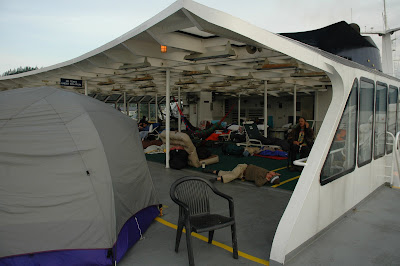
Mendenhall is called the “drive up glacier” because you can actually drive up to a visitor’s center, which is only about a mile from the edge of the ice wall. Mendenhall is only one of the 38 large glaciers originating in the Juneau ice field. The ice that is now melting at the glacier face, fell as snow on the ice field 85 years ago.
Mendenhall has retreated 2.5 miles since the mid 1700 and that rate has accelerated since 1990, when it was loosing about 60 feet per year. The last few years it has retreated 250 feet or more each year. Mendenhall is now a half-mile wide at its terminus and 150 feet from top to the underwater bottom, but for how long? In some of the pictures you can pick out the sheer line, which shows where the glacier had scraped the rock walls clean in the recent past.
An added treat were the nesting Arctic Terns with their baby chicks scurrying through the roped off brush on the beach in front of the visitors center. The chicks, looking like a ball of down, were about three weeks old. As usual, the parents were flying ceaselessly in their effort to feed the growing babies. When these chicks fledge they will be ready to fly all the way to Antarctica.


 Icebergs in Mendenhall Lake. The ones up close to the glacier are from a large event about two weeks ago. The icebergs further out (above) are from last winter. They have to melt in the lake because they are too big to go down the river.
Icebergs in Mendenhall Lake. The ones up close to the glacier are from a large event about two weeks ago. The icebergs further out (above) are from last winter. They have to melt in the lake because they are too big to go down the river. Mendenhall Visitors Center
Mendenhall Visitors Center
The Alaska State Museum was a delight. A current exhibit, covering the ingenious life style of the Yup’ik Natives, called “The Way We Live” focuses on the life, technology and beliefs of these northern dwellers. We spent most of our time in this section. Stories, transcribed from elders who were part of this culture, told about using dried fish scales for the soles on boots, sewing water and windproof parkers made from seal bladders, building kayaks from driftwood and covering them with walrus skins. These villagers lived and prospered in the most extreme conditions using imaginative techniques and resourceful skills that are becoming lost in time.
The museum also had a small section of Southeastern Native art. The original bent wood box was without its cover but was otherwise in excellent condition as was the large wall carving saved from a crumbling clan house.


One day, when there was only one cruise ship in port, we ventured down town to the Juneau-Douglas City Museum. A small building with a big movie about the evolution of Juneau, from a gold rush boomtown to today’s State Government Center. If Petersburg is called “The Town that Fish Made” then Juneau is “The Town that Gold Made”. The movie chronicled the first gold strikes made by Joe Juneau, up through the workings of at least three large mining companies that went bust, to the last remaining mine that required 20 tons of ore to produce 1 ounce of gold. This company was closed by the U.S. Government during the Second World War and never reopened.
While at this museum we spotted a sign for a narrated walking tour of Juneau’s historic district. What was billed as a 1-hour tour became a delightful 2-½ hour history lesson as well as a meet and great many town residents.
Elva, a resident for 21 years, and obviously a well loved part of down town, quoted us names and dates of people and buildings, going back to the early 1800’s. Many of her references came from newspaper accounts she had read in library archives so her commentary was sprinkled with scandalous gossip as well as factual dates and events. She obviously loved the history of this city and kept track of what the old buildings were being used for now and in the past. An old theater, currently condemned, had been used in a movie she recommended we see. “Terrible movie,” she said, “but a great setting”. Elva was the best part of the tour.
 The Russian Orthodox Church built in 1894.
The Russian Orthodox Church built in 1894.
How would you like to carry a new piece of furniture up those stairs to this house?
That afternoon we went to locate the Flume trail that was recommended by our friends Steve and Beth Fleming. Their daughter, Hillary, lived in Juneau for several years so they were familiar with the city sites. Juneau, like most of the Inside Passage cities, is built on the side of a steep mountain, which translates into very little flat area for building. At the waterfront they created more land with mine tailings, streets and housing on the upper slopes just go up.
We had planned to walk, but Elva said it was too far, so we found ourselves driving up a two way street, that had about a 12% grade, and was just wide enough for us to clear the parked cars and flower boxes placed at the edge of peoples sidewalks. This city is also called the San Francisco of the North. Think Lombardi Street. Not sure what would have happened if we met another car.
We found the Flume walk, which is touted to be the original hydro source for Juneau’s electricity. Juneau claims to have had electric lights in most of its homes long before New York City. I expected the walk to be along the side of the flume, but the trail is a boardwalk on top of the watercourse. It was interesting to walk along and hear the water running beneath our feet. Great flat walk through lush forests on a very steep hillside.
Just up the road is the Last Chance Mine Museum. We should have gone their first, because it was closed when we finished walking and poking around the flume works. This mine claims to be on the site of the first gold strike in Juneau. We talked about coming back another day, but never made it there. Next visit.
.


The Flume walk
 At this point I went to The Silver Bow Bakery for the Internet access to post our Petersburg adventures on this blog and Marlin went prowling in book stores. He called a short time later and said he found a poster for a free event at the civic center called White Nights, and to meet him there when I was finished. Well, that was shortly before the computer went into hibernating mode, even though it was plugged in. I figured the receptacle I was using was not working, so I folded my tent and headed to meet Marlin.
At this point I went to The Silver Bow Bakery for the Internet access to post our Petersburg adventures on this blog and Marlin went prowling in book stores. He called a short time later and said he found a poster for a free event at the civic center called White Nights, and to meet him there when I was finished. Well, that was shortly before the computer went into hibernating mode, even though it was plugged in. I figured the receptacle I was using was not working, so I folded my tent and headed to meet Marlin.
This was the day for unexpected treats. White Nights turned out to be a Festival of Russian Culture, featuring two separate Russian Dance troupes; The Singing Family Troika; the SitNiks, 5 musicians playing Russian music on authentic Russian instruments; and two classical piano players. One of the dance groups, The New Archangel Dancers, was made up of 12 women, performing Russian folk dances. None of them are professional dancers and none of them are Russian. They do it for fun.
At about the halfway point in the program, the lights went out, so after a short intermission, when the electricity had still not come on, stage hands moved all the chairs to the glass fronted lobby, and the performance was completed in the natural light of Juneau’s 9:30 PM twilight. We were really enjoying Juneau. Veronlka Krasheninnlkova, the leader of the Sudarushka Dancers, explained, in her charming Russian accent, why the event was called White Nights. Looking out the window she said, “What is the color of the light out side?” (white) “and what time of day is it?” (night)…
On the Monday before we left Juneau, we booked a boat trip to Tracy Arm. (Chuck, get out your map) Tracy arm is an inlet about 40 miles south of Juneau where two accessible glaciers reside. The inlet is shaped like an arm with a bent elbow and two fingers at the end, one North and one South. It was an all day trip, from 7:30 am to 6:00 pm, and what a trip it was.
We had planned to walk, but Elva said it was too far, so we found ourselves driving up a two way street, that had about a 12% grade, and was just wide enough for us to clear the parked cars and flower boxes placed at the edge of peoples sidewalks. This city is also called the San Francisco of the North. Think Lombardi Street. Not sure what would have happened if we met another car.
We found the Flume walk, which is touted to be the original hydro source for Juneau’s electricity. Juneau claims to have had electric lights in most of its homes long before New York City. I expected the walk to be along the side of the flume, but the trail is a boardwalk on top of the watercourse. It was interesting to walk along and hear the water running beneath our feet. Great flat walk through lush forests on a very steep hillside.
Just up the road is the Last Chance Mine Museum. We should have gone their first, because it was closed when we finished walking and poking around the flume works. This mine claims to be on the site of the first gold strike in Juneau. We talked about coming back another day, but never made it there. Next visit.
.


The Flume walk
 At this point I went to The Silver Bow Bakery for the Internet access to post our Petersburg adventures on this blog and Marlin went prowling in book stores. He called a short time later and said he found a poster for a free event at the civic center called White Nights, and to meet him there when I was finished. Well, that was shortly before the computer went into hibernating mode, even though it was plugged in. I figured the receptacle I was using was not working, so I folded my tent and headed to meet Marlin.
At this point I went to The Silver Bow Bakery for the Internet access to post our Petersburg adventures on this blog and Marlin went prowling in book stores. He called a short time later and said he found a poster for a free event at the civic center called White Nights, and to meet him there when I was finished. Well, that was shortly before the computer went into hibernating mode, even though it was plugged in. I figured the receptacle I was using was not working, so I folded my tent and headed to meet Marlin.This was the day for unexpected treats. White Nights turned out to be a Festival of Russian Culture, featuring two separate Russian Dance troupes; The Singing Family Troika; the SitNiks, 5 musicians playing Russian music on authentic Russian instruments; and two classical piano players. One of the dance groups, The New Archangel Dancers, was made up of 12 women, performing Russian folk dances. None of them are professional dancers and none of them are Russian. They do it for fun.
At about the halfway point in the program, the lights went out, so after a short intermission, when the electricity had still not come on, stage hands moved all the chairs to the glass fronted lobby, and the performance was completed in the natural light of Juneau’s 9:30 PM twilight. We were really enjoying Juneau. Veronlka Krasheninnlkova, the leader of the Sudarushka Dancers, explained, in her charming Russian accent, why the event was called White Nights. Looking out the window she said, “What is the color of the light out side?” (white) “and what time of day is it?” (night)…
On the Monday before we left Juneau, we booked a boat trip to Tracy Arm. (Chuck, get out your map) Tracy arm is an inlet about 40 miles south of Juneau where two accessible glaciers reside. The inlet is shaped like an arm with a bent elbow and two fingers at the end, one North and one South. It was an all day trip, from 7:30 am to 6:00 pm, and what a trip it was.
The cruise down the inside passage was spectacular on this small 48 passenger boat but the real excitement began shortly after turning into the arm when we began seeing icebergs. At one large berg, the captain pulled up close and circled it slowly so everyone could get the 80 or 100 pictures from every angle. Each different viewpoint looked more amazingly beautiful than the last. That was just the beginning.



 Hitch hikers
Hitch hikers



 Tracy Arm is a true fjord, where the sheer mountain cliffs drop straight into the water down to depths of 1 or 2000 feet. This fjord has the added attraction of glaciers and icebergs. Needless to say there are waterfalls cascading off the mountaintops everywhere and the further into the arm we traveled, the narrower and icier the waterway became.
Tracy Arm is a true fjord, where the sheer mountain cliffs drop straight into the water down to depths of 1 or 2000 feet. This fjord has the added attraction of glaciers and icebergs. Needless to say there are waterfalls cascading off the mountaintops everywhere and the further into the arm we traveled, the narrower and icier the waterway became.



I think this captain was an icebreaker navigator before piloting this boat. Just when you thought he could get no closer to the glacier because of the mass of ice covering the surface, he would continue to edge his craft slowly and cautiously nearer and nearer the glacier terminus. When he finally stopped the engines, it felt like we were about 100 feet away.
The first approach was at South Sawyer glacier, the larger of the two glaciers in Tracy Arm. Neither one is as high as Mendenhall, but the proximity made it way more exciting. At this site there were hundreds of harbor seals perched on the flat icebergs with their spring pups alongside. They stayed fairly still until the boat came too close for comfort and they slid gracefully into the water and out of sight.
 South Sawyer Glacier
South Sawyer Glacier



After a prolonged visit at South Sawyer, we motored up to North Sawyer, again picking our way through tightly packed chunks of ice. Although this glacier was not as wide or tall as South Sawyer, the pattern of ice at the terminus was much more dramatic. While we were stopped in front of the glacier, the face “calved” three times. Huge blocks of ice fell from the upper levels and since we were so close, the waves that were created as the ice cascaded into the water made the boat rock as though it were riding open ocean swells. Another 100 or so pictures!
On the return trip, the captain detoured for a visit to two prominent waterfalls. One was called “Hole in the Wall” because it fell inside a small grotto formation in the rock wall. Again, I kept taking pictures, think he was not going to get any closer, but he kept going, and going, and going, until he actually touched the prow of the boat to the wall beside the fall. The kids loved having their picture taken with the waterfall splashing their shoulders. I apologize for not remembering the name of the second fall, because this time he actually pulled up close enough to make the water pour into the boat as everyone cheered him on.


North Sawyer Glacier


The predicted rain held off until we returned to the dock at 6 pm. It rained cats and dogs all night and throughout the next day. We still had a couple of places on our list to see, but after spending the morning on chores and searching out a repair shop for the computer, we ran out of steam. We will just have to come back again some day. Maybe we will get ourselves jobs on one of the ferries for a season or two.
Our computer problem turned out to be a worn out power cord, which we were able to replace with a used one from the repair shop for about ½ the price of a new one. All in all it was a great week. On to Sitka on Wednesday the 24th. In fact, I am finishing the typing of this post while on the ferry LeConte. Stay tuned.



 Hitch hikers
Hitch hikers


 Tracy Arm is a true fjord, where the sheer mountain cliffs drop straight into the water down to depths of 1 or 2000 feet. This fjord has the added attraction of glaciers and icebergs. Needless to say there are waterfalls cascading off the mountaintops everywhere and the further into the arm we traveled, the narrower and icier the waterway became.
Tracy Arm is a true fjord, where the sheer mountain cliffs drop straight into the water down to depths of 1 or 2000 feet. This fjord has the added attraction of glaciers and icebergs. Needless to say there are waterfalls cascading off the mountaintops everywhere and the further into the arm we traveled, the narrower and icier the waterway became. 


I think this captain was an icebreaker navigator before piloting this boat. Just when you thought he could get no closer to the glacier because of the mass of ice covering the surface, he would continue to edge his craft slowly and cautiously nearer and nearer the glacier terminus. When he finally stopped the engines, it felt like we were about 100 feet away.
The first approach was at South Sawyer glacier, the larger of the two glaciers in Tracy Arm. Neither one is as high as Mendenhall, but the proximity made it way more exciting. At this site there were hundreds of harbor seals perched on the flat icebergs with their spring pups alongside. They stayed fairly still until the boat came too close for comfort and they slid gracefully into the water and out of sight.
 South Sawyer Glacier
South Sawyer Glacier


After a prolonged visit at South Sawyer, we motored up to North Sawyer, again picking our way through tightly packed chunks of ice. Although this glacier was not as wide or tall as South Sawyer, the pattern of ice at the terminus was much more dramatic. While we were stopped in front of the glacier, the face “calved” three times. Huge blocks of ice fell from the upper levels and since we were so close, the waves that were created as the ice cascaded into the water made the boat rock as though it were riding open ocean swells. Another 100 or so pictures!
On the return trip, the captain detoured for a visit to two prominent waterfalls. One was called “Hole in the Wall” because it fell inside a small grotto formation in the rock wall. Again, I kept taking pictures, think he was not going to get any closer, but he kept going, and going, and going, until he actually touched the prow of the boat to the wall beside the fall. The kids loved having their picture taken with the waterfall splashing their shoulders. I apologize for not remembering the name of the second fall, because this time he actually pulled up close enough to make the water pour into the boat as everyone cheered him on.


North Sawyer Glacier


The predicted rain held off until we returned to the dock at 6 pm. It rained cats and dogs all night and throughout the next day. We still had a couple of places on our list to see, but after spending the morning on chores and searching out a repair shop for the computer, we ran out of steam. We will just have to come back again some day. Maybe we will get ourselves jobs on one of the ferries for a season or two.
Our computer problem turned out to be a worn out power cord, which we were able to replace with a used one from the repair shop for about ½ the price of a new one. All in all it was a great week. On to Sitka on Wednesday the 24th. In fact, I am finishing the typing of this post while on the ferry LeConte. Stay tuned.













 Marlin is heating our lunch on the engine. This is an old technique he reconstructed from his past!
Marlin is heating our lunch on the engine. This is an old technique he reconstructed from his past!







